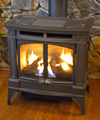 |
 |
 |
 |
 |
 |
 |
 |
 |
 |
      |

Starks Energy Economics, LLC 4th quarter 2011Focus: North Dakota's Bakken Oil Shale ProductionJobs. Man camps. Winter temperatures averaging 0-23 degrees Fahrenheit in January. Five-mile truck back-ups. Yes, we're talking Bakken. As the linked graph shows, North Dakota oil production has more than quadrupled in the last six years, to 450,000 barrels per day (BPD). Booming so fast that finding houses, apartments, or any kind of shelter is a challenge, North Dakota's unemployment rate is the lowest in the nation, about 3%. For example, the North Dakota Petroleum Council (NDPC) advertises a 13-page list of oil industry jobs. In 2010, petroleum comprised 37% of the United States' 98 quadrillion BTUs (British Thermal Units) of primary energy supply, and a third of the world's 522 quadrillion BTUs. The incentive of oil prices above $50/barrel coupled with breakthrough technologies of horizontal drilling and multistage fracturing led to developing North Dakota's Bakken oil shale, a reserve estimated at between four and twenty-four billion barrels. Even the low end of this range would make the Bakken the second-largest US discovery next to Alaska. The US Geological Service (USGS) calls the Bakken the largest continuous oil accumulation it has ever assessed. Another reason for the Bakken's rapid development is North Dakota's leasehold structure. Since mineral rights are owned by individuals rather than a national government, small production companies are able to negotiate with small, nimble owners. In the first ten months of 2011, almost 1600 drilling permits have been issued in the state. Drilling many projects quickly has meant a fast climb up the efficiency curve. The Bakken oil reserve is found mainly in North Dakota but extends west into Montana and north into Saskatchewan. Its thickness ranges from 11 feet at the edge of the formation to 180 feet at the center. The NDPC estimates that with the current fleet of rigs, fifteen to twenty years will be required to fully drill the formation. This reflects both the size of the reservoir and the nature of production, which is more like manufacturing—and similarly capital intensive. The Bakken is expected to produce for at least thirty years. Its crude is sweet (low-sulfur) and light. With gravity of 36-44 degrees API, Bakken crude is almost identical to oil trading standards West Texas Intermediate (WTI) and Brent. North Dakota oil production is projected to increase to as much as a million BPD by 2017. In August 2011—a typical month—the Energy Information Administration reports the US used 14.75 million barrels per day of crude oil. Of that, sixty percent, or nine million BPD is imported. North Dakota is already the fourth-largest oil-producing state, behind Texas, Alaska, and California. With the rapid rise in production, new pipeline shipping capacity is unavailable. Crude is shipped out by truck and rail, and a new rail terminal is under construction. Overall, Bakken crude oil production offers a welcome example of growth. |

All content © Copyright 2025 | Starks Energy Economics, LLC.